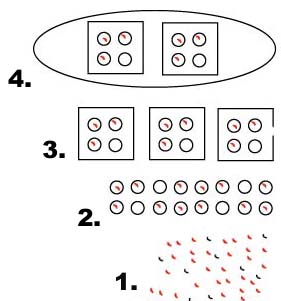|
|
Killer whales are found in all the world's oceans, from polar to tropical seas. Though their distribution is limited by pack ice, they prefer cooler waters and are most common in cold water regions such as Iceland, Norway, Japan, Antarctica, and the northeastern Pacific coast from Washington State to the Bering Sea.
(www-comm.pac.dfo-mpo.gc.ca/pages/release/bckgrnd/2002/bg008_e.htm)
Resident killer whales live in family groups of 5 to 50 whales, called pods. The pods maintain a matriarchal society with two or three older females and their descendents (i.e. childre, grandchildren, etc.) living together throughout their lives.
Resident killer whales are named such because they live in more predictable areas than transients. They primarily eat fish, and their dorsal fins tend to be rounded at the top.
Resident killer whales in the Pacific Northwest are divided into separate northern and southern communities. The northern community of resident killer whales lives off northern Vancouver Island and the mainland coast as far north as southeast Alaska. Northern residents often visit Johnstone Strait off northeastern Vancouver Island. The southern community of residents is found off southern Vancouver Island. Haro Strait and the Strait of Juan de Fuca are good places to view them. Northern and southern residents are sometimes seen in winter, but vanish for months at a time.
(www.tmmc.org/learning/education/whales/orca.asp)
Transient killer whales travel in small pods ranging from one to seven individuals who may or may not be related to each other. They do not interact with Resident killer whales.
Transient killer whales have long and unpredictable travel patterns, and can be seen anywhere at any time. They will eat many marine mammals including whales, dolphins, propoises, sea otters, and pinnipeds as well as sharks and sea birds. Hunting in groups enable them to hunt animals much larger than themselves and have been known to kill blue whales. Their dorsal fins are more pointed and they are less vocal than Residents.
At least 218 transient killer whales are known to roam the coastal waters of British Columbia and southeast Alaska.
With at least 180,000 individuals in the Antarctic waters alone, orcas are not endangered . However, there has been a 20% drop in resident orca population in the Pacific Northwest over a five-year period. The Canadian government has listed them threatened, and concerned scientists and conservation groups are also asking the United States government to list this population on the U.S. Endangered Species List.
Leading theories underlying the decline include:
- STARVATION. There has been a decrease in their favored prey (salmon) due to increased harvest for human consumption. Also, whale watching boats might interfere with their hunting.
- ACCUMULATION OF CONTAMINANTS. Polychlorinated biphenyls (PCBs) were once used in many industrial processes, but were banned in the United States in the 1970s when they were found to be dangerous. Unfortunately, concentrations of the PCBs still remain high in the environment because they settle on the ocean floor and take a long time to break down, meanwhile other countries continue to permit their use.
- Toxins like PCBs are most impacting on top predators like killer whales because even a small concentration of contaminant accumulated within a small animal travels up the food chain. Predators eating those small animals accumulate all of those toxins. This is known as bioaccumulation.
- The PCBs that have settled on to the ocean floor are filtered up by bottom-dwelling organisms, which are then eaten by fish. Animals feeding on these groundfish acquire the contaminants in their bodies. As resident orcas eat more bottom-dwelling fish instead of salmon, they accumulate more PCBs. The chemicals concentrate themselves in the blubber of these mammals and weaken their immune and reproductive systems.
- Transient orcas have recently been classified as the "most polluted" animal on earth with PCB levels nearly 500 times that found in humans. The United Nations is discussing a worldwide ban of these persistent pollutants.
- Has their been a decline in prey item for both transient and resident killer whales?
|
This web site was created by Lynn Tran at the North Carolina State University, Department of Mathematics, Science, and Technology Education on 7/12/03. Faculty advisor Dr. David Eggleston, NCSU, Department of Marine, Earth, & Atmospheric Sciences. Last updated December 29, 2003 .
